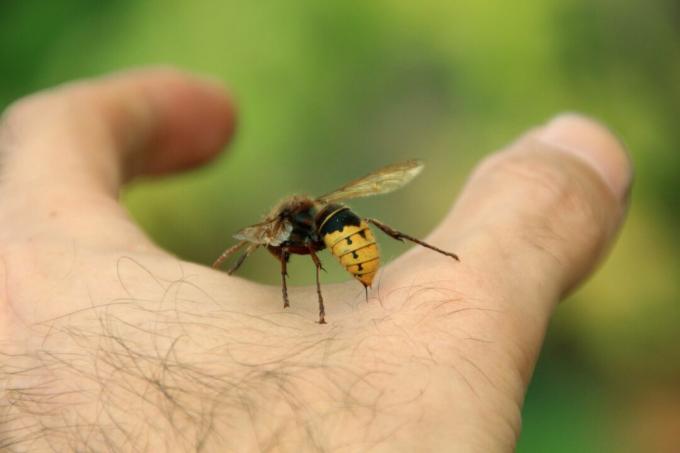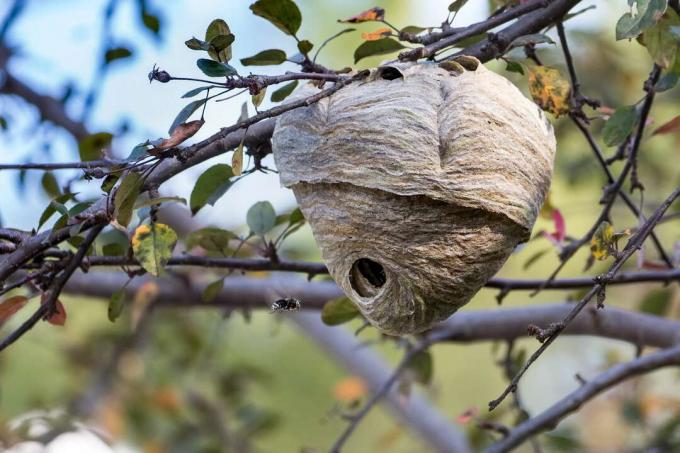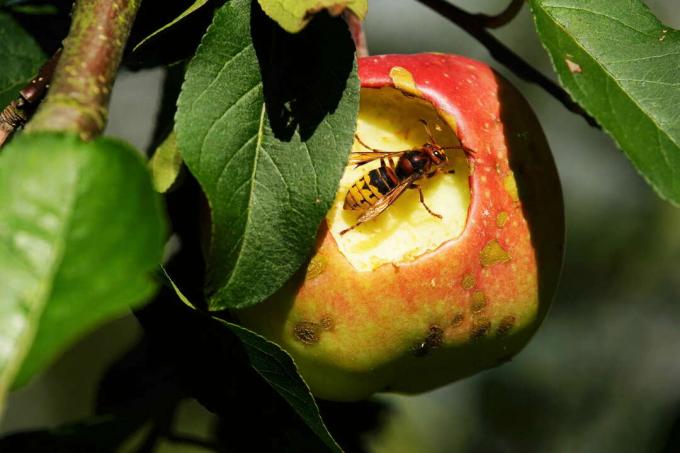Hornets and their stings are considered dangerous, but the animals are actually not aggressive and are of great value to our ecosystem.

Hornets are still widely regarded as dangerous and aggressive. However, as with many supposedly dangerous animals, this opinion is not correct. Because, in contrast to the German wasp or the common wasp, hornets are very peaceful animals. Nevertheless, hornets also defend their nests. Therefore we humans have to differentiate with regard to our rules of conduct, whether we encounter a hornet at the nest or when foraging outside its nest area.
contents
- Hornets foraging for food
- Hornet in the immediate vicinity of the nest
- Hornet sting - and what now?
- Hornet stings in allergy sufferers
- Background information: the hornet queen and her life cycle
- Hornet as a beneficial insect
Hornets foraging for food
Outside of the nest area, hornets are peaceful and generally avoid any arguments. That means: you'd rather flee than stab. Only when a hornet is squeezed or held is it ready to use its sting. In the worst case, it happens when a hornet gets caught in your clothes. Otherwise, there is no reason to be afraid of a flying hornet. They also do not fly directly at humans (unlike wasps). While wasps are attracted to meat, sweet foods and drinks and can therefore be really annoying, hornets are not to be enthusiastic about such delicacies. Because hornets are still active at dusk, they can occasionally be lured into the house by artificial light sources. Often it is enough for the light source to go out, so that the hornet can orient itself again and will soon find a way out.

Hornet in the immediate vicinity of the nest
Although hornets tend to be peaceful animals, if their nest is in direct danger, they will also become aggressive. However, if a few important points are observed, a hornet sting is more than unlikely. First of all, it is important to know at what distance from the nest a person poses a threat. For hornets this is usually 4 meters. However, if a nest is disturbed more frequently, the defense radius also increases. Should you accidentally come closer to a hornet's nest, please follow the following rules:
- Avoid quick and jerky movements
- Do not block the hornets' trajectories
- Do not generate any vibrations or loud noises
- Do not breathe directly into animals
Rather, try to withdraw slowly and calmly, then nothing should happen.
Hornet sting - and what now?
Hornet stings are considered to be particularly poisonous and with multiple stings there should even be danger to life and limb. However, this is a myth, at least for people with normal sensitivity. First of all, it is very rare that a hornet stings at all. In addition, it is also very unlikely to be attacked by several animals at the same time. In mice, for example, the venom of the honeybee is far more potent than the venom of a hornet. Therefore, at the moment there are no verifiable facts that speak for the supposedly strong poison of the hornet. The pain from a hornet sting is also no stronger than from a bee or wasp sting. Only if a hornet sticks into the mouth or throat region can the swelling cause a risk of suffocation. Then medical advice should be sought immediately. Since hornets actually have no reason to feed on humans, such a sting is very unlikely.

Hornet stings in allergy sufferers
Just as some people are allergic to bees and wasp stings, people can also be allergic to a hornet sting. The allergenic substances hardly differ in wasps and hornets, which is why there is often a cross allergy. This means that people who are allergic to wasps are also most likely to be allergic to a hornet sting. Overall, 2 - 4% of the population are said to have an allergic reaction to hornet stings. Symptoms of an allergic reaction are:
- Circulatory problems
- Rashes and swelling away from the puncture site
- Shortness of breath
If these symptoms or other physical impairments occur, a doctor must be consulted as soon as possible. Because in allergy sufferers, a hornet sting can lead to severe circulatory problems and also to anaphylactic shock (danger to life!). Even if the whole thing sounds very threatening at first: All of the dangers listed here only come about after a stab. However, if you behave correctly towards the hornets, you will hardly get a sting.
Background information: the hornet queen and her life cycle
Hornets are not aggressive animals, but rather a real miracle of nature, which can be seen above all in their special life cycle. The life of the hornets is mainly determined by their queen and her life course, which proceeds as follows:
The so-called young queens only dare to leave their winter quarters in mid-May. Rotten trees, bark or, rarely, a place in the ground serve as shelter. At first the young queen is completely on her own and starts looking for an optimal nesting place. While knotholes and other cavities are used in the natural environment, so are in those of People populated areas mostly barns, attics, and even bird nesting boxes Roller shutter boxes. Once a good spot has been found, the young queen immediately starts building the nest. For this, saliva-salivated wood is used, which has been finely chewed beforehand. The first eggs are then placed in the still small nest and the first workers hatch after four weeks. Now the queen can take care of her actual task: the ongoing egg production. The workers now take care of the nest maintenance, brood care and food procurement.

The behavior of the hornet colony changes in late summer. Now more and more sex animals are hatching, these are male drones and new young queens who can mate. They ensure the maintenance of the hornet population for the next year. This is also when the hornet population density is highest. As a rule there are 200-300 animals, but in some cases a colony can consist of up to 600 animals.
From October the number of hornets steadily decreases and the colony begins to die. Before that, however, there is still an important event - the wedding flight. The young queens are fertilized by the drones. The fertilized young queens are now looking for winter quarters in which they can survive the cold season in order to be able to found a new colony next year. All other hornets, including the old queen, do not survive the winter.
Hornet as a beneficial insect
While the large wasps do not have a good reputation, they are extremely useful. Because the hornet larvae are only fed with insects and arthropods. Since this also includes many unpopular pests, the hornets make an important contribution to the regulation of harmful insects. A single hornet colony can feed an enormous number of insects and other animals to the hungry larvae every day. The adult hornets, on the other hand, are strict vegetarians and feed on windfalls, tree sap and, rarely, flower nectar.

Hornets have got their bad reputation completely wrong: They are not aggressive animals that humans get out of Whims and moods sting, but highly complex creatures that are of enormous importance for a healthy ecosystem are.
Even Wasps do not have a good reputation with most people. Here you can find out everything about the annoying insects and their nests.



